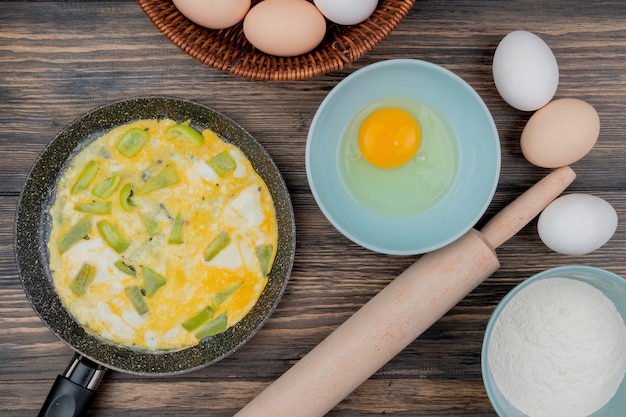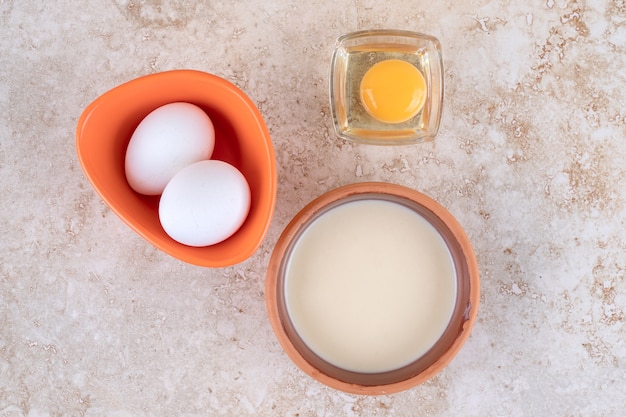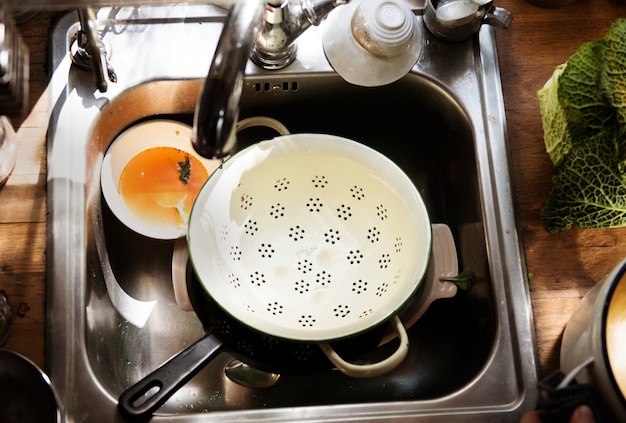There's something incredibly satisfying about a perfectly cooked soft-boiled egg. The silky smooth white, that vibrant, runny yolk, and the delicate balance of textures – it's a culinary masterpiece in its simplicity. But achieving that ideal soft-boiled egg isn't always a walk in the park. I've certainly had my fair share of overcooked yolks, rubbery whites, and that dreaded green ring around the yolk. But over the years, I've learned a thing or two about this delightful breakfast staple, and I'm here to share my hard-earned knowledge with you.
This isn't just another guide; this is a journey into the world of soft-boiled egg perfection. We'll delve into the science behind the cooking process, explore different techniques, and offer a foolproof timing guide, ensuring you can achieve that flawless runny yolk every time. So grab a cup of tea, settle in, and let's get cooking!
(Part 1) The Science of Soft-Boiling

Before we dive into the practicalities, let's understand the science behind transforming a humble egg into a delectable treat. It all boils down to the interplay of heat and protein.
Understanding Egg Proteins
Imagine the egg white as a delicate network of protein molecules. When heat is applied, these proteins start to unravel and intertwine, forming a solid structure. This is what gives the egg white its firm texture. Now, let's talk about the yolk. It's a fascinating mixture of proteins and fats, which makes it a bit more forgiving than the white. It can withstand more heat before solidifying, creating that luscious, creamy texture we all love.
The Impact of Time and Temperature
The key to a perfect soft-boiled egg lies in cooking the white just enough to set while leaving the yolk beautifully runny. This delicate balance is achieved by controlling the cooking time and temperature.
Short cooking times, around 3-4 minutes, will result in a very runny yolk, perfect for dipping toast or adding to a creamy bowl of porridge. Longer cooking times, 6-7 minutes, will give you a more set yolk, ideal for slicing and adding to salads, sandwiches, or even a hearty breakfast bowl.
Temperature also plays a crucial role. Boiling water (212°F or 100°C) cooks eggs faster than simmering water (185°F or 85°C). This is why you'll often hear people recommend simmering the eggs rather than boiling them, as it gives you more control over the cooking process.
(Part 2) The Tools of the Trade

Now that we've grasped the scientific principles, let's equip ourselves with the right tools for the job. The right equipment can make all the difference in achieving that perfect soft-boiled egg.
1. The Pot:
A medium-sized saucepan is your best friend. It should be large enough to comfortably hold the eggs without overcrowding, allowing for even cooking. A pot with a lid is ideal for controlling the steam and preventing heat loss.
2. The Eggs:
fresh eggs are non-negotiable. Older eggs tend to have a larger air pocket, which can lead to uneven cooking and an unpleasant rubbery texture. Aim for eggs that are within a week or two of their expiration date.
3. The ice bath:
This is your secret weapon for stopping the cooking process instantly. An ice bath immediately cools the eggs, preventing the yolk from overcooking and ensuring a silky smooth consistency. It also helps firm up the eggs, making them easier to handle.
4. A Timer:
Precision is key when it comes to soft-boiled eggs, and a timer is your trusted ally. Opt for a timer with a loud alarm, so you don't miss that crucial moment when the eggs are cooked to perfection.
5. A Slotted Spoon:
A slotted spoon is a must-have for gently lowering the eggs into the boiling water and lifting them out. It also helps drain excess water from the eggs after they've been cooked.
(Part 3) Getting Started: The Prep Work

Now that we've gathered our tools, let's prepare for the egg-cellent adventure ahead! The prep work is essential for a successful soft-boiled egg experience.
1. Gather Your Tools:
Ensure you have everything within reach: the pot, eggs, ice bath, timer, and slotted spoon. It's a good idea to have everything set up and ready before you start boiling the water.
2. Fill the Pot:
Fill the pot with enough water to cover the eggs by about an inch. Bring the water to a rolling boil over high heat. It's important to have the water boiling vigorously before adding the eggs.
3. Prepare the Ice Bath:
Fill a large bowl with ice and cold water. The key is to have enough ice to maintain the water temperature. This will ensure the eggs cool down quickly and stop the cooking process effectively.
(Part 4) The Cooking Process: A Step-by-Step Guide
Finally, we're ready for the moment of truth! This is where your patience and attention to detail will pay off. Follow these steps carefully to achieve that perfect soft-boiled egg.
1. Gently Add the Eggs:
Once the water is boiling vigorously, carefully lower the eggs into the pot using the slotted spoon. It's essential to do this gently to avoid cracking the eggshells. Aim for a smooth, graceful descent into the boiling water.
2. Set the Timer:
Start the timer immediately after adding the eggs. This is where you'll need to choose your desired level of doneness. Remember, cooking times can vary depending on the size of your eggs. If you're aiming for a very runny yolk, aim for 3-4 minutes. For a more set yolk, go for 6-7 minutes.
3. Ice Bath Time:
When the timer goes off, immediately transfer the eggs from the pot to the ice bath using the slotted spoon. Allow the eggs to cool for 5-10 minutes, ensuring the cooking process is stopped completely.
(Part 5) The Ultimate Timing Guide
Here comes the moment of truth - the timing guide! This table provides an estimated cooking time for different levels of doneness. Remember, these are just starting points. The ideal cooking time will vary based on the size of your eggs and your personal preference. Adjust the timing as needed until you achieve that perfect level of doneness.
Timing Guide for Soft-Boiled Eggs:
| Level of Doneness | Cooking Time (minutes) |
|---|---|
| Very Runny Yolk (Dippable) | 3-4 |
| Slightly Runny Yolk (Good for Slicing) | 5-6 |
| Set Yolk (Solid) | 7-8 |
(Part 6) Beyond the Basics: Advanced Tips
Now that you've mastered the fundamentals, let's explore some advanced techniques to elevate your soft-boiled egg game. These tips will help you achieve even more consistent results and add a touch of finesse to your egg-cooking skills.
1. The Salt Trick:
Adding a pinch of salt to the boiling water helps the egg whites set more evenly, resulting in a smoother, more consistent texture. The salt also helps prevent the eggs from cracking during cooking, ensuring a beautiful, intact shell.
2. The Vinegar Method:
Adding a splash of vinegar to the boiling water helps coagulate the egg whites faster, creating a smoother surface and a more aesthetically pleasing appearance. It also helps prevent the egg from sticking to the pot, making the peeling process easier.
3. The Cold Water Start:
Some chefs prefer to start with cold water and bring it to a boil along with the eggs. They believe this method creates a more even cooking, but it can take a bit longer. Experiment with both methods to see which you prefer.
4. The "Roll and Crack" Method:
To prevent the eggs from cracking during cooking, gently roll the eggs on the counter before adding them to the pot. This helps create a more consistent shell, reducing the risk of cracks forming during the boiling process.
5. The Shell Removal Trick:
To make peeling the shell easier, gently tap the bottom of the egg on a hard surface after the ice bath. This creates a small crack in the shell, making it easier to peel off.
(Part 7) Serving and Enjoying Your Perfect Soft-Boiled Egg
You've done it! You've cooked the perfect soft-boiled egg. Now, it's time to enjoy your masterpiece. Here are a few serving ideas to inspire your culinary creativity.
1. The Classic:
The classic way to enjoy a soft-boiled egg is with a slice of buttered toast. Simply cut the top off the egg and let the runny yolk run onto your toast. It's a simple, comforting dish that's always a crowd-pleaser.
2. Salads and Sandwiches:
Soft-boiled eggs can add a touch of luxury to salads and sandwiches. They can be sliced thinly or halved and placed on top of a salad, or added to sandwiches for an extra layer of flavour and texture.
3. Soups and Stews:
Add a soft-boiled egg to your favourite soup or stew for a hearty, satisfying meal. The yolk adds richness and creaminess to the dish, creating a more decadent and luxurious flavour profile.
4. Breakfast Bowls:
Soft-boiled eggs are a perfect addition to a hearty breakfast bowl. Add them to a bowl of oatmeal, quinoa, or yogurt for a nutritious and satisfying start to your day.
5. Avocado Toast:
Elevate your avocado toast game by adding a soft-boiled egg on top. The creamy yolk blends beautifully with the avocado, creating a delicious and satisfying breakfast or brunch option.
(Part 8) FAQs (Frequently Asked Questions)
You've got questions, I've got answers! Here are some frequently asked questions about soft-boiled eggs.
1. What happens if I overcook my soft-boiled eggs?
Overcooked soft-boiled eggs will have a firm yolk that's no longer runny. The white may also become tough and rubbery. The ideal soft-boiled egg should have a silky smooth white and a beautifully runny yolk.
2. Can I reheat soft-boiled eggs?
It's not recommended to reheat soft-boiled eggs as the yolk will become tough and rubbery. The best way to enjoy them is fresh from the ice bath.
3. Why is there a green ring around the yolk?
The green ring around the yolk is caused by a chemical reaction between iron in the yolk and sulfur in the white. It's harmless, but it's a sign that the egg has been overcooked.
4. What happens if I don't use an ice bath?
Without an ice bath, the cooking process will continue, resulting in a firmer yolk and potentially a tougher white. The ice bath is crucial for stopping the cooking process instantly and ensuring the yolk retains its desired texture.
5. Can I use different types of eggs?
Yes, you can use different types of eggs, like duck eggs or quail eggs. However, the cooking time may need to be adjusted. Duck eggs and quail eggs have different protein structures, so the cooking times will be different.
6. How do I store leftover soft-boiled eggs?
To store leftover soft-boiled eggs, place them in a sealed container in the refrigerator. They can be stored for up to 3 days. However, the texture may change slightly over time.
So there you have it, your comprehensive guide to cooking the perfect soft-boiled egg! With a little patience and this guide by your side, you'll be creating mouthwatering soft-boiled eggs in no time. Embrace the science, experiment with different techniques, and discover your perfect soft-boiled egg experience. Enjoy!
Everyone is watching

How to Cook Frozen Lobster Tails Perfectly: A Step-by-Step Guide
RecipesLobster. Just the word conjures up images of lavish meals, special occasions, and a taste of luxury. But let's...

Pigs in a Blanket Cooking Time: How Long to Bake for Perfect Results
RecipesAh, pigs in a blanket. Just the name conjures up images of those delightful little parcels of crispy pastry en...

Pork Fillet Cooking Time: How Long to Cook It Perfectly
RecipesPork fillet, or tenderloin as it's sometimes called, is a real favourite in our house. It's so versatile, and...

The Ultimate Guide to Tender, Juicy Pulled Pork
RecipesRight, let's talk pulled pork. It's one of those dishes that just screams "comfort food," doesn't it? I mean...

The Ultimate Guide to Cooking Delicious Frankfurters
RecipesLet's face it, we all love a good frankfurter. It's a classic, simple, and always satisfying. But let's be rea...
